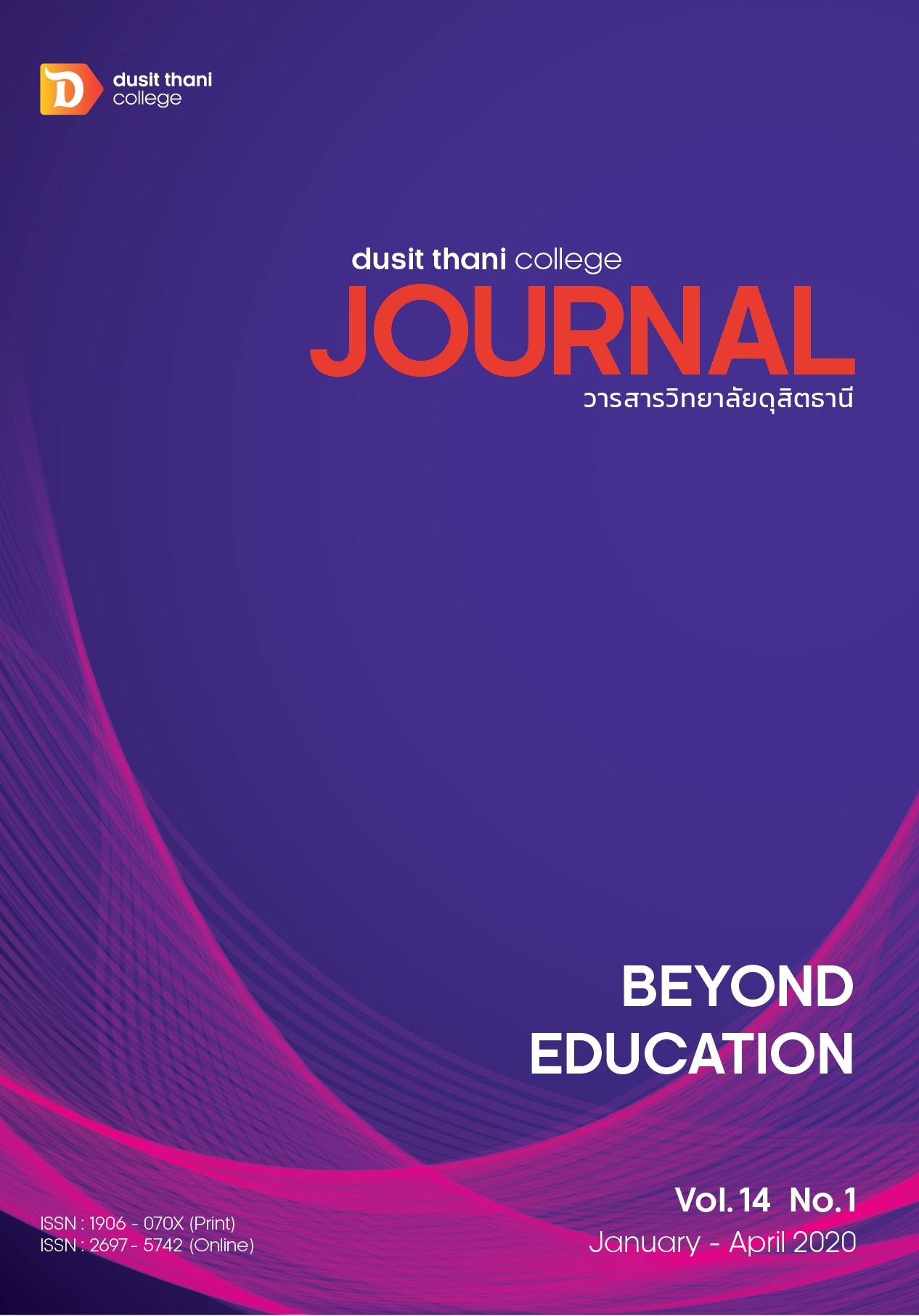Guidelines for the Development of the Potential Tourism Model, Baan Sa Kla Village Samut Prakarn Province
Main Article Content
Abstract
This research aims to explore tourism resources and evaluate tourism potential of Baan Sa Kla Village, Samut Prakarn Province; to propose the development model of tourism. This research is a qualitative research by using purposive sampling from stakeholders who are representative from government agencies, village representatives and tourists. Semi-structured interview was methods of collecting qualitative data in this research. A survey of the tourism resources of the Baan Sa Kla community, based on the Five A's of Tourism criteria. It was found that the community tourism resources in full the whole composition 5 criteria, including 1) Attractions 2) Accessibilities 3) Accommodation 4) facilities and Amenities and 5) Activities. Evaluation of potential tourist attractions. Evaluation of potential tourist attractions. There were found that Baan Sa Kla community has the potential to develop into a tourist attraction in all 6 parts. The researchers designed activity as an itinerary for One Day Trip. This is a cooperation with related government agencies and local people in the community. The development of tourism in the community as a guideline for sustainable tourism management.
Article Details
Article Screening Policy
- All research and academic articles to be published must be considered and screened by three peer reviews in the relevant field / article.
- All articles, texts, illustrations and tables published in the journal are the personal opinions of the authors. Editors don't always have to agree. And no responsibility whatsoever is the sole responsibility of the author.
- The articles to be published must never be published. Where did you first publish? And not in the consideration of other journals If the audit found that there has been a duplicate publication It is the sole responsibility of the author.
- Any article that the reader sees as being plagiarized or impersonated without reference. Or mislead the work of the author Please let the journal editor know it will be your greatest blessing.
References
Sukhothai Thammathirat Open University, 286. Nonthaburi: STOU. (in Thai)
2. Emphan, Datchanee. (2007). Community Based Tourism development and homestay
events. Bangkok: Text and Journal publication.
3. Etsuko, Okazaki. (2008). A Community-Based Tourism Model: Its Conception and Use.
Journal of Sustainable Tourism, 16(5), 511 - 529.
4. Haywood, K. Michael. (1988). Responsible and responsive tourism planning in the community.Tourism Management, 9(2), 105 - 118.
5. Loedlukthanathan, Sirikorn. (2007). An action research for sustainable river tourism
program development in Kwai Noi, Kanchanaburi province. Master thesis, M.S.
(Planning and Management Ecotourism). Bangkok: Graduate School, Srinakharinwirot
University. (in Thai)
6. Nopparat Satarat. (2010). Sustainable management of community-based tourism in
Thailand. National Institute of Development Administration/Bangkok.
7. Ohrisdska-Olson et al. (2010). Creative Tourism Business Model and its Application in
Bulgaria. Proceedings of the Black Sea Tourism Forum 'Cultural Tourism – The
Future of Bulgaria,' 2010. Available at SSRN: https://ssrn.com/abstract=1690425
8. Pimpandee, Kreangsak. et al. (2011). Strategic of sustainable tourism Development. Case
study: The Development of Sakla community to Culture Tourism and Sustainable
Tourism. Bangkok: King Prajadhipok's Institute. (in Thai)
9. Praprutkit, S. (2010). An Evaluation of Attraction Site in Amphur Muang, Changwad Trad
to Create the Ecotourism Route. Master thesis, M.Sc. (Ecotourism Planning and
Management). Bangkok: Graduate School, Srinakharinwirot University. (in Thai)
10. Sotear, Ellis. (2011). Community based tourism in Cambodia: exploring the role of
community for successful implementation in least developed countries.
Retrieved from https://ro.ecu.edu.au/theses/451
11. Srirathu, Vipha. (2008). Eco-tourism Potential of Amphoe Khao Kho, Phetchabun
Province. Bangkok: Graduate School, Srinakharinwirot University.
12. Swarbrooke, John. (1999). Sustainable Tourism Management. Wallingford, UK: CABI.
13. Tancharoen, Sudthanom. (2017). Community Based Tourism Management and
Sustainable Tourism Development of Bangkantaek Community in
Samutsongkhram Province. Phetchaburi Rajabhat University, 8(2), 32 - 41.
14. Thailand CBT Network Coordination Center. (2017). Community Based Tourism
Activities. Retrieved From
https://thaicommunitybasedtourismnetwork.wordpress.com/cbtproduct/
15. Tourism Western Australia. (2009). “Tourism Australia”. Annual Report. 2009 - 2010.
16. World Tourism Organization. (2011). The Travel& Tourism Competitiveness Report2011.
Retrieved From https://www.ryt9.com/s/bot/1474787
17. Wurzburger, Rebecca. (2009). Creative Tourism: A Global Conversation. Creative
Tourism in Santa Fe, USA: New Mexico.
18. Wisudthiluck, Suddan et al. (2014). Creative Tourism in Thailand: Problems and Obstacles
Case Studies of Ceramic and Cotton Quilt Making.Thammasat Review 17(1)
January - June, 2014 pp.163 - 179. Paper presented at ICOT 2014, the International
Conference on 25 - 28 June, 2014 Dalian, China.


